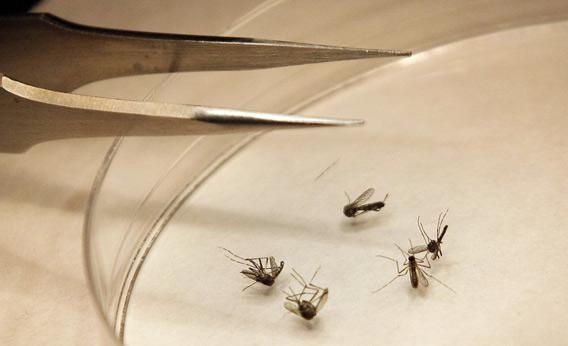This year’s outbreak of West Nile virus appears to be the worst ever in the United States, according to the Centers for Disease Control and Prevention. Most people infected with the virus have no symptoms. But a small percentage get a fever, or more seriously, brain inflammation—especially scary since there is no treatment. This summer brought heartbreaking cases, like a mother of four who died of West Nile on her youngest child’s birthday. In Dallas, officials sent planes to blanket the region with insecticide, since the virus is spread by mosquitoes. One infectious disease expert went so far as to say: “Anyone experiencing slight headaches, rashes, and a fever should consult a physician for immediate attention.” Parents’ anxiety has naturally surged, with stories that urge them to “Protect kids against West Nile as they go back to school,” featuring vigilant mothers like this one who says, “We spray them with mosquito spray constantly.”
And yet the data shows that West Nile is actually much less likely to cause severe disease in children than in older people, a pattern that has held since the disease first appeared in the United States more than a decade ago. The reasons for this aren’t clear. But it does mean that parents can relax a little.
West Nile virus was first identified in Uganda in the 1930s. The disease made its American debut in 1999, in a spate of cases in New York City. That strain was closely related to one isolated the previous year from an Israeli goose, suggesting that West Nile in the United States might be of Middle Eastern origins. Birds often serve as a reservoir of the virus, which can also infect animals like horses, alligators, and squirrels. After the New York City outbreak, West Nile began to spread across the country, causing unpredictable outbreaks from year to year. This year’s major hotspot is Texas, where almost 40 percent of the reported cases have occurred. Overall, since 1999, tens of thousands of cases have been reported around the country, resulting in more than a thousand deaths.
Strikingly, though, the disease has not hit children as hard as other age groups. So far this year, more than 3,000 cases of West Nile have been reported to the CDC, with 134 deaths But only around 4 percent of those cases have been in people under the age of 20. That’s in contrast to about 17 percent in people ages 20 to 39, and about 41 percent in people 60 or older.
A small part of the age discrepancy may be explained by testing practices. West Nile, in its milder forms, can look like many other childhood ills, which also cause rashes, fever and malaise. The tests that would confirm a West Nile diagnosis can give false negatives when administered too early (because they look for antibodies to the virus, which the body may not have produced in sufficient quantities when a person first becomes ill). Given that there is no treatment, pediatricians may be more inclined to see if a mild fever simply runs its course, rather than pushing for a definitive diagnosis.
But that’s not the whole story, as the data on severe cases of the disease show. In a small proportion of cases (less than 1 percent), West Nile infects the central nervous system, causing conditions like encephalitis and meningitis, which are forms of inflammation of the brain or of the membranes lining the brain and spinal cord. These are potentially grave—and far less likely to go undiagnosed. And these serious bouts of West Nile turn up a lot less frequently in children. Between 1999 and 2008, according to the CDC, there were about five such cases per 10 million people per year among children under 10. For adults 70 and over, meanwhile, the rate was far higher—135 cases per 10 million per year. The kids under 10 had the lowest rate of serious disease of any age group, with the proportions zooming upward through adulthood and into old age. (To take a look at the CDC graph, click here and scroll down to Figure 7.) A similar pattern emerges in the data from 2009, 2010, and 2011. (The relevant numbers aren’t posted in the same form for 2011, unfortunately, but the CDC says the pattern is the same.)
What’s going on? Children probably aren’t exposed to fewer mosquitoes than their parents and grandparents, and they probably don’t become infected at a lower rate, according to Marc Fischer, a West Nile expert at the CDC. For some reason, though, their bodies often seem better able to shrug it off without getting really, really sick. This is in contrast to another mosquito-borne disease, called La Crosse virus, which frequently causes meningitis and encephalitis, and has a much higher incidence in children than older people. No one seems to know exactly why.
In the coming weeks, the CDC’s West Nile totals will keep climbing, since it takes time for cases to be confirmed and reported, even though the number of infections has probably peaked for the year. But unless you live in a particular hotspot, like Texas, you probably don’t need to keep your kids slathered in DEET. You don’t want them to feed the mosquitoes. But you don’t need to panic, either.
